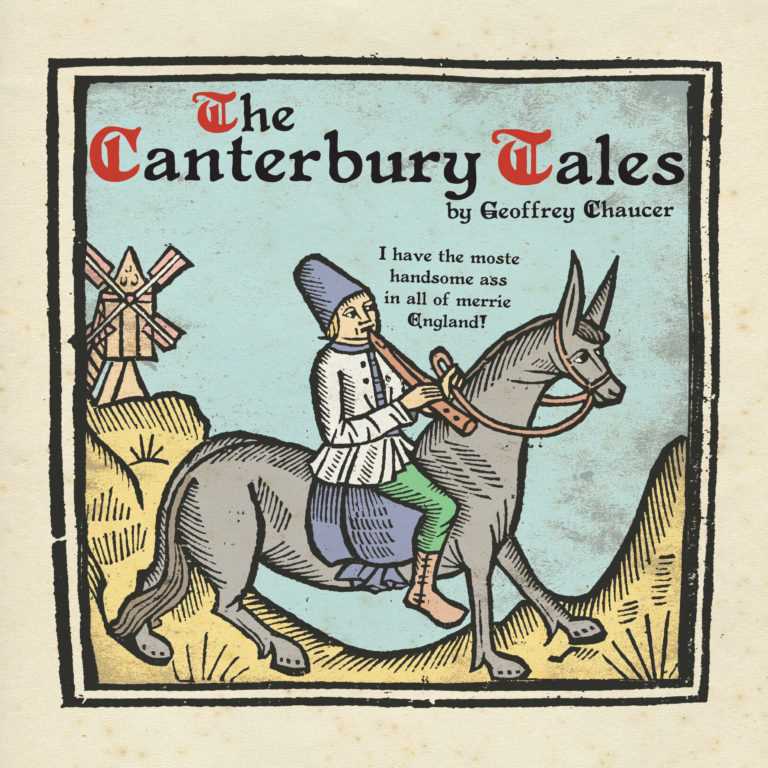
Are you ready to embark on a literary journey through the medieval world? The Canterbury Tales test is designed to test your knowledge and understanding of Geoffrey Chaucer’s iconic work. This collection of stories takes readers on a pilgrimage to Canterbury, where a diverse group of pilgrims share tales of love, morality, and societal issues.
With its intricate plotlines, vivid characters, and rich historical context, The Canterbury Tales is a revered masterpiece of English literature. Through this test, you will have the opportunity to demonstrate your understanding of Chaucer’s storytelling techniques, as well as your ability to identify key themes and analyze the characters’ motivations and moral messages.
Be prepared to answer questions that will require you to recall specific details from the text, such as the names of characters, the order of the tales, and the lessons learned from each story. Additionally, you will be asked to analyze the social and cultural aspects of Chaucer’s England, as reflected in the tales and the interactions between the pilgrims.
Whether you are a student studying literature or simply an avid reader, the Canterbury Tales test will challenge your knowledge and offer a deeper appreciation for the intricacies of Chaucer’s work. Get ready to delve into a world of medieval storytelling and uncover the timeless truths hidden within The Canterbury Tales.
Understanding the Canterbury Tales: A Brief Overview
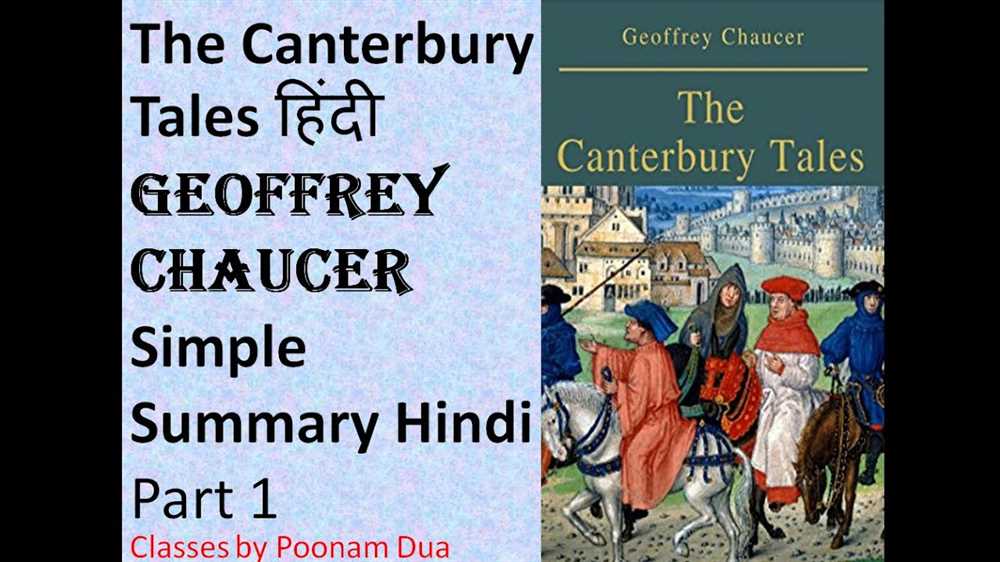
Geoffrey Chaucer’s Canterbury Tales is a collection of stories written in Middle English during the 14th century. The work is widely regarded as one of the greatest works of literature in the English language, showcasing Chaucer’s skill in storytelling and his keen observation of medieval society.
The Canterbury Tales is set within a frame narrative, where a group of pilgrims gather at the Tabard Inn in Southwark, London, and embark on a journey to the shrine of Saint Thomas Becket in Canterbury. As they travel together, each pilgrim tells a tale, resulting in a diverse and entertaining assortment of stories.
The characters in the Canterbury Tales represent various social classes and occupations of medieval England, ranging from the noble Knight to the lowly Pardoner. Chaucer uses these characters to satirize and critique the society of his time, exploring themes of love, morality, deception, and social hierarchy.
The tales themselves cover a wide range of genres, including romance, fabliau, moral fable, and allegory. Some of the most famous tales include “The Miller’s Tale,” a bawdy story of infidelity and revenge, and “The Wife of Bath’s Tale,” which challenges traditional views on gender and relationships.
Overall, the Canterbury Tales is a rich and multi-faceted work that offers a fascinating glimpse into medieval England and provides valuable insights into human nature and society.
The Background and Context of the Canterbury Tales
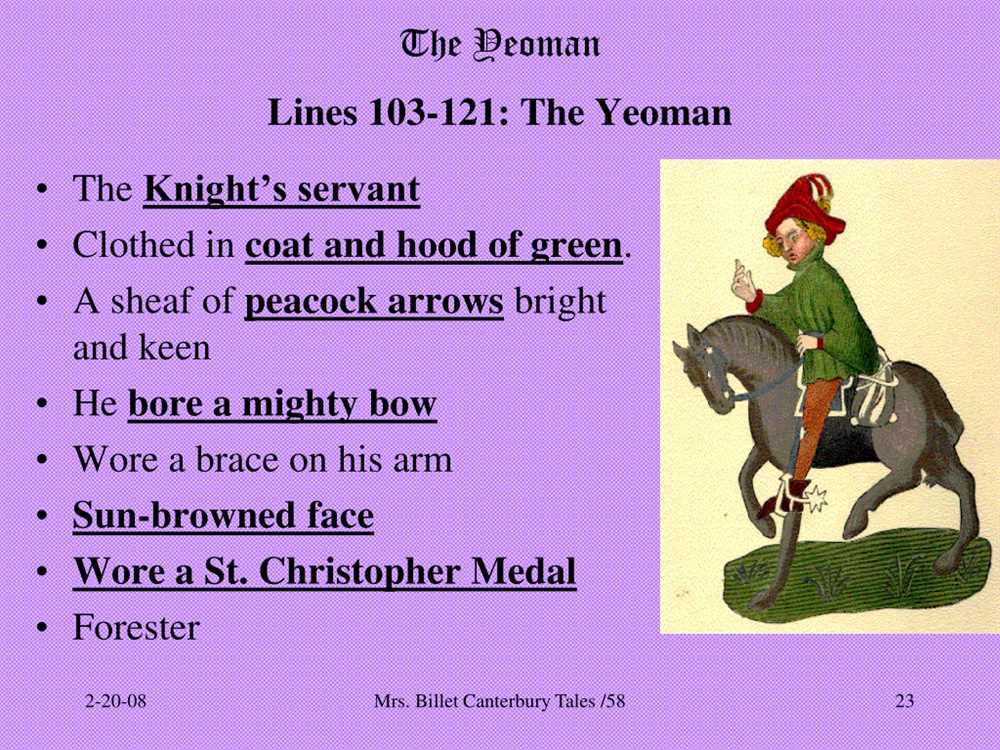
The Canterbury Tales is a collection of stories written by Geoffrey Chaucer in the 14th century. It is one of the most important works of English literature and provides a vivid depiction of medieval life in England. Written in Middle English, the tales are framed as a pilgrimage to the shrine of Saint Thomas Becket in Canterbury, where a diverse group of pilgrims from different social backgrounds gather together.
The Canterbury Tales offers a unique glimpse into the social and cultural landscape of the time. Chaucer’s work reflects the changing nature of English society, with various characters representing different aspects of medieval life. The tales cover a wide range of themes and genres, including romance, comedy, and moral allegory.
The diverse characters in the Canterbury Tales come from different social classes and professions, such as the knight, the miller, the prioress, and the merchant. This diversity allows Chaucer to explore the interactions and tensions between various social groups, offering insightful commentary on the complexities of society during the time period.
Chaucer’s use of the pilgrimage as a framing device is significant, as it provides a context for the tales and creates a sense of unity among the characters. The journey to Canterbury becomes an opportunity for the pilgrims to share their stories, entertain each other, and engage in friendly competition. Each tale reflects the individuality and unique perspectives of the characters, while also contributing to the larger narrative of the pilgrimage.
In conclusion, the Canterbury Tales is a rich and complex work that captures the spirit of medieval England. Through its portrayal of diverse characters and their stories, Chaucer provides valuable insights into the social, cultural, and literary landscape of the time. The tales continue to be studied and appreciated today for their timeless themes and enduring relevance.
The Author of the Canterbury Tales: Geoffrey Chaucer
Geoffrey Chaucer, often referred to as the father of English literature, was a poet and author who lived in the 14th century. He is most famous for his work “The Canterbury Tales,” a collection of stories written in Middle English.
Chaucer was born in London around the year 1343 and grew up in a relatively privileged household. He had connections to the royal court and served as a page to an aristocratic family. These experiences likely influenced his later works, as he had firsthand exposure to the social and political dynamics of his time.
Chaucer’s writing style was innovative for his time, as he used the vernacular English instead of Latin or French. This decision allowed him to reach a wider audience and contributed to the development of the English language as we know it today. His use of vivid characters, relatable themes, and a variety of narrative techniques made “The Canterbury Tales” an instant success.
The collection consists of stories told by a diverse group of pilgrims traveling to the shrine of Thomas Becket in Canterbury. Each tale reflects the personality and social position of its narrator, providing a fascinating glimpse into medieval society. Chaucer’s skill in portraying human nature and his keen observations of the intricacies of human behavior are evident throughout the tales.
Geoffrey Chaucer’s Canterbury Tales remains a timeless masterpiece and a crucial piece of English literature. His contribution to the development of the English language and his ability to capture the essence of human nature continue to inspire readers and scholars to this day.
Key Themes and Messages in the Canterbury Tales
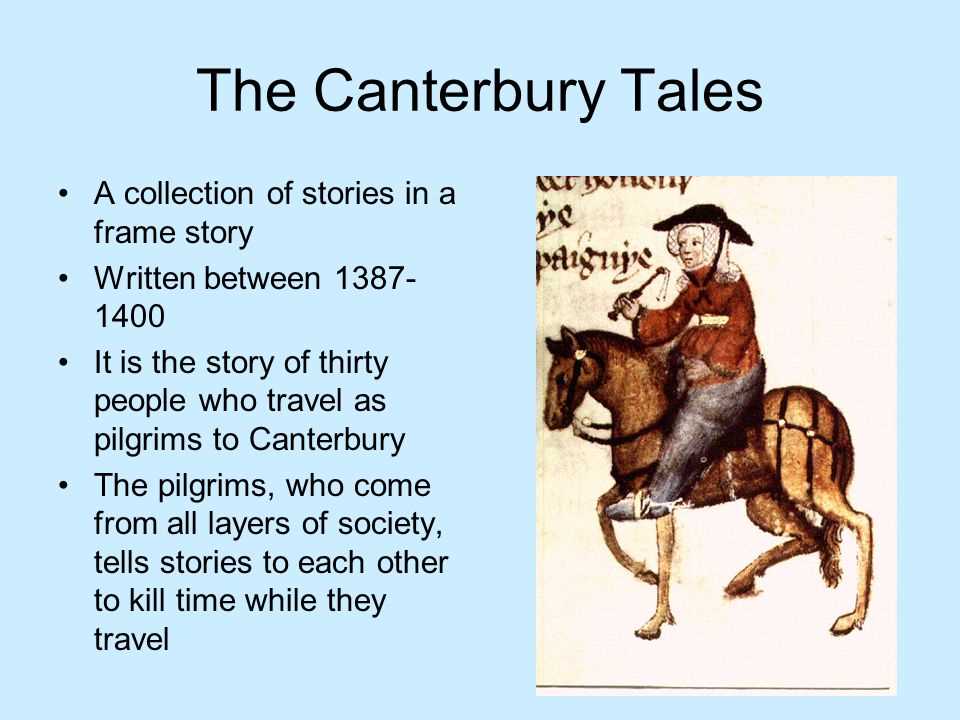
The Canterbury Tales, written by Geoffrey Chaucer in the 14th century, is a collection of stories that explores various themes and provides insightful messages about human nature, morality, and society. Through its diverse cast of characters and their tales, Chaucer delves into the complexities of human behavior and highlights the flaws and virtues that exist within individuals and communities.
1. Social Hierarchy and Status: One of the central themes in the Canterbury Tales is the exploration of social hierarchy and the struggles that arise from it. Chaucer portrays characters from different social classes, including knights, clergy, merchants, and peasants, and emphasizes the disparities between them. Through this, he critiques the societal norms that dictate one’s worth based on their social standing, highlighting the hypocrisy and corruption that often comes with power.
2. Morality and Ethics: Another significant theme in the Canterbury Tales is the exploration of morality and ethics. Chaucer questions the traditional notions of right and wrong and presents characters who challenge societal norms and expectations. The tales often involve moral dilemmas, where characters are faced with decisions that test their integrity and reveal their true nature. Chaucer encourages readers to reflect on their own values and the consequences of their actions.
- Some of the tales, such as “The Wife of Bath’s Tale,” explore the themes of gender equality, sexual agency, and power dynamics within marriage. Chaucer challenges the patriarchal conventions of his time and raises questions about the role of women in society.
- In contrast, tales like “The Pardoner’s Tale” highlight the dangers of greed, hypocrisy, and the corrupting influence of wealth. Chaucer exposes the moral decay within the church and questions the authenticity of religious figures.
3. Satire and Critique: Chaucer employs satire and sharp wit throughout the Canterbury Tales to critique various aspects of medieval society. He exposes the vices and follies of different characters, often through elements of humor and irony. By satirizing individuals and institutions, Chaucer prompts readers to reflect on the flaws and absurdities of their own time.
Overall, the Canterbury Tales serves as a profound commentary on human nature, societal norms, and the complexities of morality. Through its diverse array of characters and their tales, Chaucer invites readers to question and reflect on the timeless issues that continue to shape our world today.
Social Critique and Satire in the Canterbury Tales
The Canterbury Tales, written by Geoffrey Chaucer in the 14th century, is a collection of stories that reflects the social, political, and religious aspects of medieval England. One prominent feature of the tales is Chaucer’s use of social critique and satire to expose the flaws and hypocrisy of different social classes and institutions. Through his characters and their stories, Chaucer provides a critical commentary on the society of his time.
One of the key targets of Chaucer’s social critique is the clergy. In “The Pardoner’s Tale,” for example, Chaucer satirizes the corruption and greed of the Church by depicting a Pardoner who preaches about the consequences of sin while indulging in sinful behavior himself. The Pardoner is portrayed as manipulative and deceitful, exploiting people’s fear of damnation to enrich himself. This critique of the Church’s practices and the hypocrisy of its representatives highlights Chaucer’s discontent with the religious institution and its influence on society.
Another aspect of society that Chaucer critiques is the feudal system and the aristocracy. In “The Knight’s Tale,” Chaucer presents a romanticized view of chivalry and courtly love, but also subtly exposes the inequities and injustices inherent in the system. The noble characters, such as Duke Theseus and his wife Hippolyta, are shown to be flawed and driven by their own self-interests. Chaucer’s portrayal of the corruptive influence of power and wealth within the aristocracy serves as a critique of the social hierarchy and the privilege enjoyed by the nobility.
- Chaucer also satirizes the emerging middle class in tales such as “The Merchant’s Tale” and “The Wife of Bath’s Tale”. The Merchant, for example, represents the materialistic nature of the rising merchant class, pursuing profit above all else. Through his characters, Chaucer criticizes the greed and deceitfulness that often accompanied the pursuit of wealth.
- Furthermore, Chaucer includes characters from different professions and social classes in his tales, such as the Miller, the Reeve, and the Summoner, each representing a specific stereotype or social group. Through these characters, Chaucer provides a satirical commentary on the foibles and vices of each class, often exposing their hypocrisy, greed, and immorality.
Overall, the Canterbury Tales serve as a powerful social critique and satire of medieval society. Chaucer’s use of various characters and their stories allows him to present a multifaceted view of the flaws and hypocrisies prevalent in different social classes and institutions. Through his commentary, Chaucer sheds light on the problems and inequalities of his time and offers a critical examination of the society in which he lived.
The Role of Religion and Morality in the Canterbury Tales
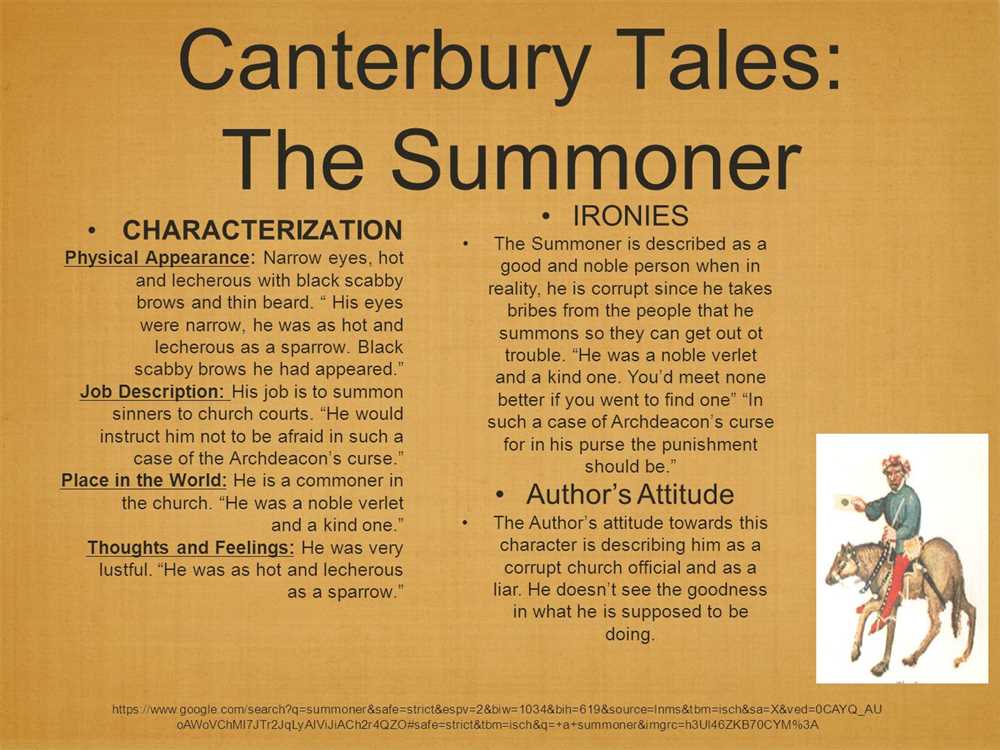
The Canterbury Tales, written by Geoffrey Chaucer in the 14th century, explores various aspects of medieval society, including the role of religion and morality. Throughout the collection of tales, Chaucer presents different characters from different social backgrounds, each with their own perspectives on religion and morality.
Religion plays a significant role in the Canterbury Tales, as many of the pilgrims are on a religious pilgrimage to the shrine of Thomas Becket. The tales provide a window into the religious beliefs and practices of the time, ranging from devout piety to hypocrisy. Chaucer portrays religious figures such as the Pardoner and the Friar in a satirical light, highlighting their moral corruption and greed. He also includes characters like the Parson and the Knight, who exemplify virtuous and devout behavior.
Chaucer uses the tales to explore the complexities of morality, presenting a diverse range of characters and their moral dilemmas. The tales often raise questions about what is considered morally right or wrong, and challenge conventional notions of morality. For example, in “The Miller’s Tale,” the characters engage in deceit and infidelity, but the story ends with a moral lesson about the consequences of such behavior. Similarly, in “The Pardoner’s Tale,” the Pardoner himself preaches against the sin of greed, highlighting the irony of his own corrupt practices.
Overall, the Canterbury Tales provide a nuanced and multifaceted portrayal of religion and morality. Chaucer’s characters reflect the complexities of human nature and the tension between religious ideals and human flaws. The tales serve as a critique of societal norms and challenge readers to reflect on their own beliefs and values.
Characters in the Canterbury Tales: Analysis and Significance
The Canterbury Tales, written by Geoffrey Chaucer in the 14th century, is a collection of stories told by different pilgrims during their journey to the shrine of Saint Thomas Becket. The characters in these tales represent a wide range of social classes and personalities, providing an insightful portrayal of medieval society. By analyzing and understanding the significance of these characters, we can gain a deeper understanding of the themes and social commentary present in the tales.
One of the notable characters in the Canterbury Tales is the Wife of Bath. She is a strong-willed and outspoken woman who has been married five times. Her character challenges traditional gender roles and expectations, highlighting the complexities of women’s experiences in medieval society. Through her tales and prologue, the Wife of Bath raises questions about love, marriage, and power dynamics, offering a critical commentary on the gender norms of the time.
The Knight is another important character in the Canterbury Tales. As a noble and chivalrous figure, he represents the ideals of knighthood and honor. However, his character is not without flaws. Despite his noble status, the Knight has participated in wars and battles, causing suffering and death. This contradiction between his noble reputation and his actions reflects the moral ambiguity and complexities of the medieval society, where even the most esteemed individuals are not immune to their flaws.
- Chaucer’s characters in the Canterbury Tales serve as a microcosm of medieval society, encompassing various social classes, occupations, and personalities.
- The Wife of Bath challenges traditional gender roles and provides social commentary on marriage and power dynamics.
- The Knight represents the ideals of knighthood, but also reflects the moral ambiguities present in medieval society.
By analyzing and delving into the significance of these characters, readers can not only appreciate the complexity of medieval society but also gain insights into the human condition and universal themes that transcend time and place.